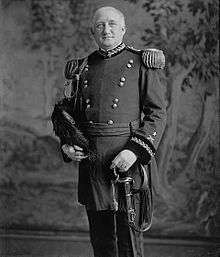Erasmus M. Weaver, Jr.
| Erasmus Morgan Weaver, Jr. | |
|---|---|
 | |
| Born |
May 23, 1854 Lafayette, Indiana |
| Died |
November 13, 1920 (aged 66) Washington, D.C. |
| Place of burial | Arlington National Cemetery |
| Service/branch | United States Army |
| Years of service | 1875–1918 |
| Rank | Major General |
| Commands held |
Chief of the Militia Bureau U.S. Army Coast Artillery Corps |
| Battles/wars |
Spanish–American War World War I |
Erasmus Morgan Weaver, Jr. (May 23, 1854 – November 13, 1920) was a United States Army Major General who served as the first chief of the Militia Bureau and the Chief of the Army's U.S. Army Coast Artillery Corps.
Biography
The son of Erasmus M. Weaver, a prominent businessman of Lafayette, Indiana, Erasmus Morgan Weaver, Jr. was born in Lafayette on May 23, 1854. He graduated from the United States Military Academy in 1875 and received his commission as a Second Lieutenant of Artillery.[1]
Weaver's subsequent assignments included Professor of Military Science at Western Reserve University[2] and The Citadel (1883–1885),[3] and Instructor in Chemistry and Electricity at the United States Military Academy (1888–1891).[4]
From 1895 to 1896 Weaver studied at the Massachusetts Institute of Technology.[5][6]
In 1898 Weaver was appointed to the temporary grade of Lieutenant Colonel of the 5th Massachusetts Infantry, a volunteer regiment raised during the Spanish–American War. Initially the organization's mustering officer, he subsequently commanded its 1st Battalion.[7][8]
From 1908 to 1911 Weaver served as head of the Army's Militia Bureau, the first person to hold the position. In this assignment he was responsible for overseeing the training and readiness of the National Guard.[9]
Weaver was the Chief of the Coast Artillery Corps from 1911 until his retirement in 1918, when he was succeeded by Frank W. Coe. He was promoted to Brigadier General in 1911 and Major General in 1916. From 1917 until his retirement he also served as a member of the War Council that the War Department created to oversee planning for World War I.[10][11]
Weaver died in Washington, D.C. on November 13, 1920.[12] He is buried in Arlington National Cemetery, Section SE, Site 1800.[13]
General Weaver was the father of Major General Walter Reed Weaver (1885–1944).[14]
Hawaii's Fort Weaver and Fort Weaver Road were named for him.[15]
References
- ↑ Henry Blaine Davis, Generals in Khaki, 1998, page 373
- ↑ United States Military Academy Association of Graduates, Annual Report, 1921, pages 126 to 128
- ↑ John Peyre Thomas, The History of the South Carolina Military Academy, 1893, page 360
- ↑ George Washington Cullum, United States Military Academy Association of Graduates, Biographical Register of the Officers and Graduates of the U.S. Military Academy, Volume 4, 1901, page 8
- ↑ Massachusetts Institute of Technology, Technology Review, Volume 23, 1921, page 82
- ↑ J.T. White, Inc., The National Cyclopaedia of American Biography, Volume 20, 1927, page 123
- ↑ Massachusetts Secretary of State, Public Documents of Massachusetts, Volume 10, 1899, page 155
- ↑ George Washington Cullum, Edward Singleton Holden, Biographical Register of the Officers and Graduates of the U.S. Military Academy, Volume 4, page 254
- ↑ United States Infantry Association, Infantry Journal, Volume 5, 1908, page 292
- ↑ Facts on File, Inc., The World Almanac & Book of Facts, 1914, page 397
- ↑ George Washington Cullum, Edward Singleton Holden, Biographical Register of the Officers and Graduates of the U.S. Military Academy, 1920, Volume VI-A, page 201
- ↑ U.S. Army Artillery School, U.S. Army Coast Artillery School, Journal of the United States Artillery, Volume 53, 1920, page 556
- ↑ U.S. Department of Veterans Affairs, Nationwide Gravesite Locator
- ↑ George Washington Cullum, United States Military Academy Association of Graduates, Biographical Register of the Officers and Graduates of the U.S. Military Academy, 1920, Volume VI-B, page 1404
- ↑ Prescott Evening Courier, "Forts Named in Honor of Dead in War", Associated Press, May 30, 1922
Sources
- Erasmus M. Weaver, Jr. page at ArlingtonCemetery.Net
- "General Weaver Retires", New York Times, May 22, 1918
- Erasmus M. Weaver, Jr. page at Find A Grave
| Military offices | ||
|---|---|---|
| Preceded by New Position |
Chief of the National Guard Bureau 1908–1911 |
Succeeded by Robert K. Evans |